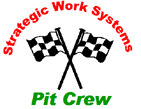You’ve certainly heard of it. Many of today’s Lean Manufacturing teachers, consultants, workshops, publications, and initiatives describe a Lean Toolbox. This toolbox contains the various improvement “tools” that have become part of the Lean Manufacturing initiative. These “tools” are being displayed, applied, adapted, and adopted as part of the newest improvement strategy for manufacturing, and business in general.
Have you looked into this Lean Toolbox? I have seen many of these over the past 12 years or so since the term “Lean” was coined to describe the Toyota Production System (where TPM emerged to address equipment effectiveness).
What is in these Lean Toolboxes? Well, it varies from consultant to consultant, from company to company, and from university to university. Here are a few of the most common, across-the-board Lean Tools:
- waste (or “muda”) elimination
- visual factory
- 5S
- six sigma
- pull scheduling
- value stream mapping
- cell design
- kaizen blitz
And in many cases, to use these Lean Tools, one has to adopt some new terminology including:
- takt time
- Jidoka
- poka-yoke
- heijunka
- kaikaku
- Kanban
- kaizen
All of a sudden, there appears to be a whole box full of new tools to help us achieve “Lean.”. But most of these tools are not new, and there are some basic tools missing. (More on that later.)
We are being told that to become “Lean,” we must learn and apply all of these Lean Tools. Workshops and seminars are flourishing. Books, videos and CD-ROMs are being sold. Green belts and black belts are being trained and certified. In case you didn’t notice, this is growing into a big business not only in manufacturing, but also in many diverse businesses that wish to become “Lean.” And in some cases, there are major improvements in on-time deliveries, meeting the customers’ expectations, reductions in order processing time, and cost reductions through the elimination of waste.
So, what’s the problem? Well, I grew up as a mechanic and have worked out of toolboxes for years; and there are a few important things I learned in all these years of tinkering, troubleshooting, problem solving, fixing, repairing, and even maintaining. First of all, the quality of your tools and how you use them can make or break your effectiveness. I also learned long ago that the measure of success is not whether you used all of the tools in your toolbox but rather whether you used the right tools properly to correct and even eliminate the problem. Here’s my Mechanic’s Tool Box 101 eight-step lesson:
- Determine what the basic problem is.
- Gather sufficient information to define the depth and scope of the problem (data).
- Make an informed decision about what to do to correct the problem (hypothesis).
- Select the right tools and parts – only the tools and parts most likely needed to address the problem.
- Try to correct the problem using the tools and parts (experiment).
- Test it to see if the “fix” really worked (measure).
- If it didn’t, go back and reassess the problem and the partial fix.
- If it did, change something so the problem won’t happen again (standardize).
Simply put, this is the basic “scientific method” we learned in school. It’s proven, and it works if you follow the process.
So, what tools are missing from the Lean Toolbox? Many of today’s “Lean Thinkers” have totally missed the point that equipment reliability and availability are the stable foundation upon which the Lean Manufacturing Enterprise is built.
While manufacturing improvement initiatives sweep the executive suites and decisionmakers’ offices like a firestorm, changing their appearances like chameleons each decade, asset care often falls by the wayside. The equipment and machinery in today’s plants are often overlooked by comparison. Think about it: The single largest manufacturing investment, the most significant element of productivity is designed, built, installed, and maintained by the smallest and, often times, most under-staffed and underskilled groups of people.
Maintenance and reliability seem like a business afterthought. It’s typically up to the plant engineering departments, reliability engineers, and maintenance departments to care for the capital assets including manufacturing facilities, utilities, processing equipment, and machinery that are at the very core of productivity, profitability, and competitiveness of manufacturing businesses.
Now, when you really think about it, the tools in the “Lean Toolbox” cannot work effectively without reliable equipment. Yes, the equipment of manufacturing. It began in the Industrial Revolution of the 1700s and 1800s when machines began replacing labor. Machines became the core of the “new” model of manufacturing capability and capacity.
Today, until we use the proven tools of maintenance and reliability to make our equipment and facilities reliable and available, to perform at “world-class” levels, “Lean” will never, never be achieved, nor sustained.
Now, where did I put that new Lean Toolbox?
© 2003
Robert M. Williamson
Strategic Work Systems, Inc.
Columbus, NC 28722
RobertMW2@cs.com
![]() Download a PDF of this article by clicking here Lean Toolbox
Download a PDF of this article by clicking here Lean Toolbox
